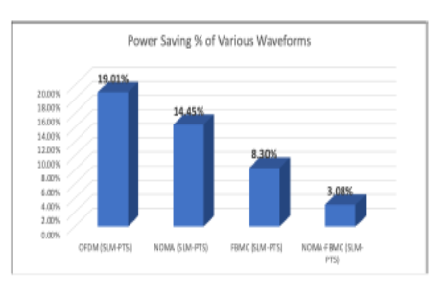


Indian Journal of Science and Technology
DOI: 10.17485/IJST/v15i41.1528
Year: 2022, Volume: 15, Issue: 41, Pages: 2182-2187
Original Article
Mohit Kumar Sharma1, Arun Kumar2*
1Department of Electronics and Communication Engineering, JECRC University, Jaipur, INDIA
2Department of Electronics and Communication Engineering, New Horizon College of Engineering, Bengaluru, Karnataka, INDIA
*Corresponding Author
Email: [email protected]
[email protected]
Received Date:22 July 2022, Accepted Date:15 September 2022, Published Date:08 November 2022
Objectives: In this work, we investigate suitable techniques to reduce the Peak to Average Power Ratio (PAPR) for advanced modulation schemes in order to obtain better performance than current or commonly used modulation schemes for Fourth Generation (4G) and Fifth Generation (5G). Methods: The proposed scheme incorporates a combination of Selective Mapping (SLM) and Partial Transmission Scheme (PTS) and thereby efficiently minimizes the PAPR and the complexity of the framework. Further, it is seen that the proposed algorithm is crucial to achieving better spectral and power characteristics compared with the existing waveforms. Findings: The comparative results of the bit error rate (BER) and PAPR of the advanced SLM-PTS when applied to the OFDM, FBMC, NOMA, and NOMA-FBMC structures are shown, and it is found that the power and complexity are significantly decreased in the advanced waveforms, which makes the proposed algorithm efficient for the advanced waveforms. Novelty: A natural motivation for future modulation schemes is to harmoniously merge the newer modulation technique, Filter Bank Multi Carrier (FBMC), with the Non-Orthogonal Multiple Access (NOMA) framework. This has led to a recent modulation paradigm called FBMC-NOMA, wherein the NOMA power domain principle is applied to a group of FMBC modulated signals. The proposed SLM-PTS-based NOMA-FBMC structure efficiently enhances the throughput and PAPR performance for 5G and beyond 5G systems. Keywords: PAPR; FBMC; SLM; PTS; NOMA
© 2022 Sharma & Kumar. This is an open-access article distributed under the terms of the Creative Commons Attribution License, which permits unrestricted use, distribution, and reproduction in any medium, provided the original author and source are credited. Published By Indian Society for Education and Environment (iSee)
Subscribe now for latest articles and news.